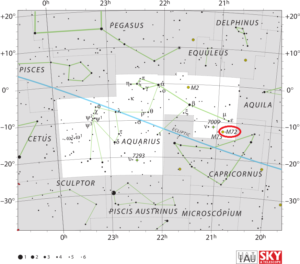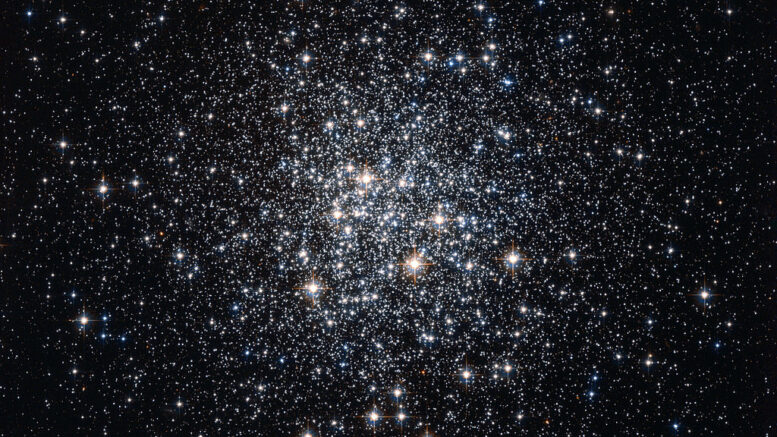Messier 72 is a globular star cluster located in the constellation Aquarius, the Water Bearer. Pierre Méchain, a French astronomer and colleague of Charles Messier, discovered the globular cluster M72 in 1780. It was the first of five star clusters that Méchain would discover while assisting Messier and, at a distance of 50,000 light-years from Earth, it is one of the most remote clusters in Messier’s catalog. M72 is located in the constellation Aquarius and has an apparent magnitude of 9.4. The cluster appears as a faint patch of light in small telescopes, and the best time to observe it is during September.
| Description | |
| Visible From Pacific Northwest | June To September |
| Best Time To Observe | June and July |
| Minimum Size Of Viewing Device | Medium Sized Telescope |
| Object Type | Globular Cluster |
| Designations | Messier 72, M72, NGC 6981, GCl 118, C 2050-127, MWSC 3419 |
| Right Ascension | 20h 53m 27.70s |
| Declination | -12°32’14.3” |
| Constellation | Aquarius |
| Number Of Stars | More Than 100,000 |
| Apparent magnitude | +9.35 |
| Apparent dimensions | 6′.6 |
| Object Radius | 53 light years |
| Distance From Earth | 54,570 light years |
History
Messier 72 was discovered by Charles Messier’s colleague Pierre Méchain on August 29, 1780. Messier found the object on October 4 together with Messier 73, which lies about 1.5 degrees to the east. He added them both to his catalogue, describing M72 as a faint nebula.
John Herschel observed M72 with a larger telescope and described it as a bright “cluster of stars of a round figure.” He catalogued the object as h 2090 and later added it to the General Catalogue as GC 4608, describing it as a “globular cluster; pretty bright; pretty large; round; gradually much compressed toward the middle, well resolved.”
American astronomer Harlow Shapley observed the cluster and noted a similarity to two other Messier objects: Messier 4 and Messier 12.
Locating M72 In The Sky
Messier 72 can be found in the western part of Aquarius, near the asterism that Charles Messier listed in his catalogue as Messier 73. M72 lies a few degrees below the imaginary line drawn from Sadalmelik to Sadalsuud, two brightest stars in the constellation, in the direction of Dabih, the second brightest star in Capricornus. The cluster can also be located about 3 degrees south and 1.5 degrees east of the magnitude 3.77 star star Albali, Epsilon Aquarii.

Viewing M72
In small telescopes, M72 appears as a faint nebula and it takes a medium-sized instrument to resolve the stars in the surrounding field. Larger telescopes will reveal a cluster with an apparent diameter of 2.5 arc minutes. The full angular diameter of M72 is 6.6 arc minutes, corresponding to a spatial extension of 106 light years. 12-inch telescopes will resolve the cluster’s core region, which occupies 1.25 arc minutes of apparent sky. The best time of year to observe M72 is during the summer.
Photographing M72
Messier 72 isn’t necessarily the most popular target, but there are some great websites with some tips and help for those looking to image the object. The best way to find tips will be in the links below or astrobin and cloudynights. The larger the telescope, the more detail will be revealed, but also will the capture time will increase.
https://www.skyatnightmagazine.com/news/messier-72/
Sources And Further Reading
Descriptions of all of Messier Objects can be found here.
https://www.nasa.gov/feature/goddard/2017/messier-72
https://freestarcharts.com/messier-72

Be the first to comment on "Messier 72"